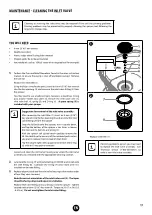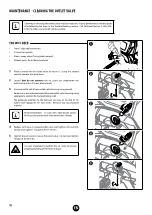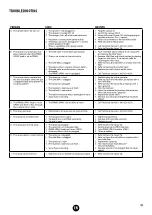
4
EN
IMPORTANT SAFETY INFORMATION
•
High-pressure spray is able to inject toxins into the body and
cause serious bodily injury. In the event that injection occurs,
seek medical attention immediately.
•
Check hoses and parts for signs of damage, a leak can inject
material into the skin. Inspect hose before each use. Replace
any damaged hoses or parts. Only use Wagner original-high-
pressure hoses in order to ensure functionality, safety and
durability.
•
This system is capable of producing 1600 PSI / 11.1 MPa. Only
use replacement parts or accessories that are specified by the
manufacturer and that are rated a minimum of 1600 PSI. This
includes spray tips, nozzle guards, guns, extensions, fittings, and
hose.
•
Always engage the trigger lock when not spraying. Verify the
trigger lock is functioning properly.
•
Verify that all connections are secure before operating the unit.
•
Know how to stop the unit and bleed pressure quickly. Be
thoroughly familiar with the controls. Pressure will not be released
by turning off the motor. The PRIME/SPRAY valve or pressure
bleed valve must be turned to their appropriate positions to
relieve system pressure. Refer to PRESSURE RELIEF PROCEDURE
described in the pump manual (page 7).
•
Always remove the spray tip before flushing or cleaning the
system.
i
NOTE TO PHYSICIAN: Injection into the skin is
a traumatic injury which can lead to possible
amputation. It is important to treat the injury
as soon as possible. DO NOT delay treatment
to research toxicity. Toxicity is a concern with
some coatings injected directly into the blood
stream. Consultation with a plastic surgeon or
reconstructive hand surgeon may be advisable.
WARNING: EXPLOSION OR FIRE
Solvent and paint fumes can explode or ignite.
Severe injury and/or property damage can occur.
PREVENTION:
•
Do not spray flammable or combustible materials near an
open flame, pilot lights or sources of ignition such as hot
objects, cigarettes, motors, electrical equipment and electrical
appliances. Avoid creating sparks from connecting and
disconnecting power cords.
•
Do not spray or clean with liquids having a flash point of less
than 38ºC (100ºF). Flash point is the temperature at which a fluid
can produce enough vapor to ignite.
•
Paint or solvent flowing through the equipment is able to result
in static electricity. Static electricity creates a risk of fire or
explosion in the presence of paint or solvent fumes. All parts
of the spray system, including the pump, hose assembly, spray
gun and objects in and around the spray area shall be properly
grounded to protect against static discharge and sparks. Use
only conductive or grounded high-pressure airless paint sprayer
hoses specified by the manufacturer.
•
Verify that all containers and collection systems are grounded to
prevent static discharge.
•
Connect to a grounded outlet and use grounded extension
cords (electric models only). Do not use a 3 to 2 adapter.
•
Do not use a paint or solvent containing halogenated
hydrocarbons. Such as chlorine, bleach mildewcide, methylene
chloride and trichloroethane. They are not compatible with
aluminum. Contact the coating supplier about compatibility of
material with aluminum.
•
Keep spray area well ventilated. Keep a good supply of fresh
air moving through the area to keep the air within the spray
area free from accumulation of flammable vapors. Keep pump
assembly in well ventilated area. Do not spray pump assembly.
•
Do not smoke in the spray area.
•
Do not operate light switches, engines, or similar spark
producing products in the spray area.
•
Keep area clean and free of paint or solvent containers, rags, and
other flammable materials.
•
Know the contents of the paint and solvents being sprayed.
Read all material Safety Data Sheets (SDS) and container labels
provided with the paints and solvents. Follow the paint and
solvent manufacture’s safety instructions.
•
Place pump at least 20 feet (6 meters) from the spray object in
a well ventilated area (add more hose if necessary). Flammable
vapors are often heavier than air. Floor area must be extremely
well ventilated. The pump contains arcing parts that emit sparks
and can ignite vapors.
•
Plastic can cause static sparks. Never hang plastic to enclose
spray area. Do not use plastic drop cloths when spraying
flammable material.
•
Fire extinguisher equipment shall be present and working.






































